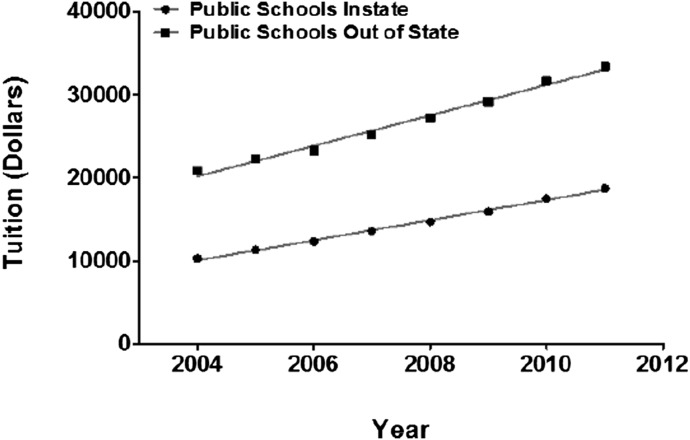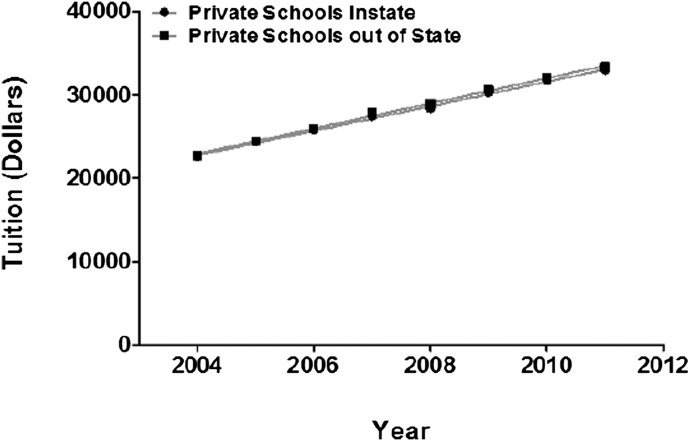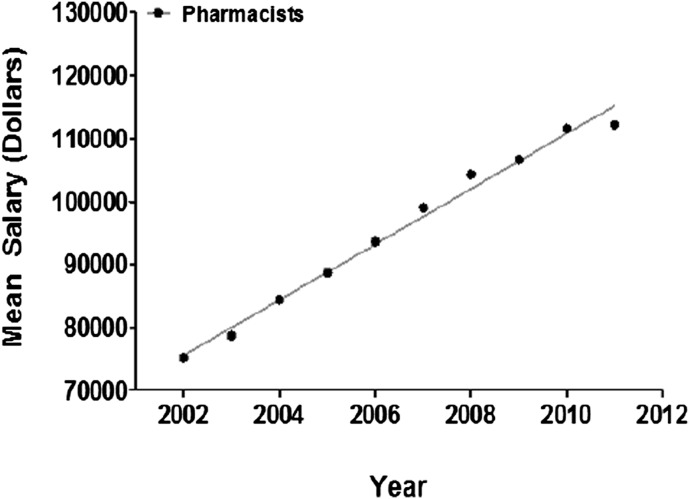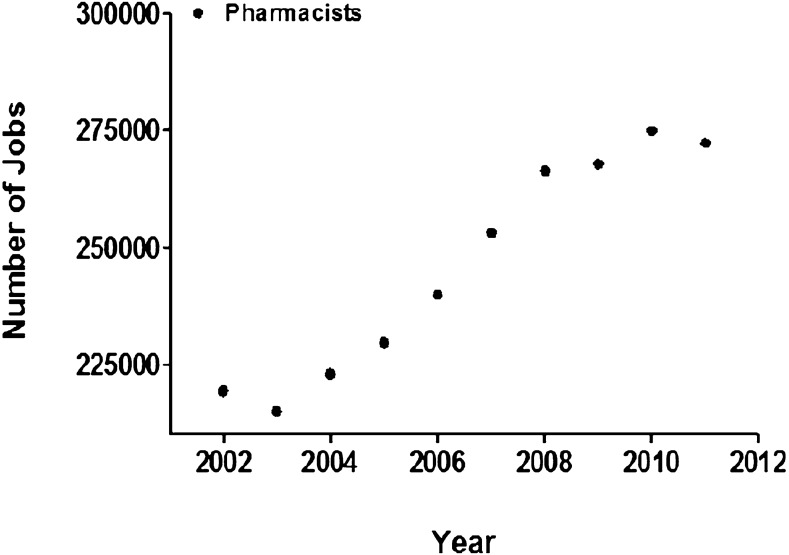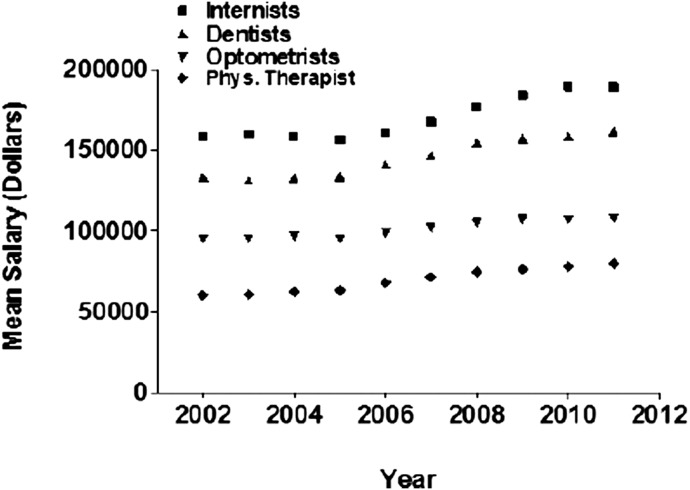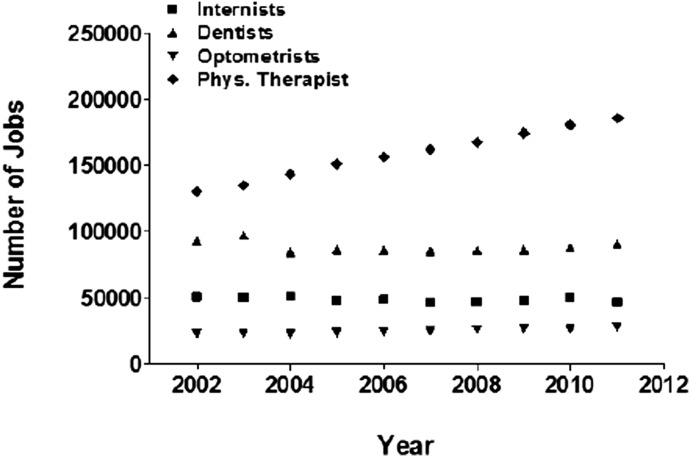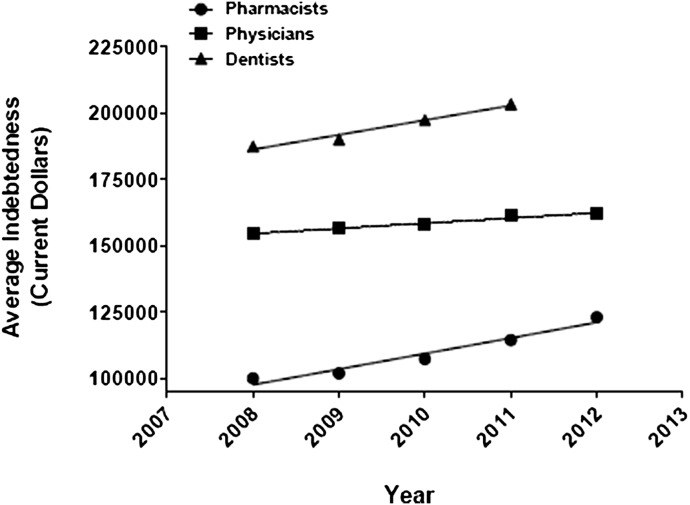Abstract
Objective. To describe the current landscape within the profession of pharmacy regarding student tuition, indebtedness, salaries, and job potential.
Methods. Pharmacy tuition and student debt data were obtained through the American Association of Colleges of Pharmacy Institutional Research website. Tuition was defined as average first-year tuition and fees for accredited schools. Debt was defined as the total average amount borrowed. Median salaries and numbers of jobs were obtained from the United States Department of Labor.
Results. In-state tuition at public schools rose an average of $1,211 ± 31 (r2 = 0.996), whereas out-of-state tuition at public schools rose significantly faster at $1,838 ± 80 per year (r2 = 0.988). The average tuition cost for pharmacy school has increased 54% in the last 8 years. The average pharmacist salary has risen from $75,000 to over $112,000 since 2002. The increase in salary has been nearly linear (r2 = 0.988) rising $4,409 ± $170 dollars per year. However, average salary in 2011 was $3,064 below the predicted value based upon a linear regression of salaries over 10 years. The number of pharmacist jobs in the United States has risen from 215,000 jobs in 2003 to 275,000 in 2010. However, there were 3,000 fewer positions in 2012 than in 2011. In 2011, average indebtedness for pharmacy students ($114,422) was greater than average first-year salary ($112,160).
Conclusion. Rising tuition and student indebtedness is a multifaceted problem requiring attention from a number of parties including students, faculty members, universities, and accreditation and government entities.
INTRODUCTION
The cost of pharmacy school and the related issue of student loan debt is at the forefront of issues plaguing higher education.1 The question of whether college is worth the financial investment has even been raised.2 The cost of pharmacy education continues to rise with average tuition rates near $25,000 per year (public and private combined).3 These tuition increases have led to sizable debt loads for graduates entering the workforce, with the average student loan debt reaching $123,063 in 2012.4 The critical question that prospective student pharmacists must ask is whether future salaries will be sufficient to provide the necessary return on investment for their pharmacy education.
The profession of pharmacy is not alone in this regard; there are similar concerns within the fields of medicine and dentistry.5-8 The average annual tuition and fees for medical schools in 2011-2012 (public and private) was $39,500, while total student indebtedness was on average $161,290 (2010 data).9,10 Likewise, the dental profession has even higher figures, with the average annual tuition and fees in 2011 at $42,737 and average student indebtedness at $203,374 in 2011.11,12
In order to answer the question regarding whether the investment in professional education will pay off in financial terms, the current job markets and salary surveys must also be analyzed. According to workforce reports from the Bureau of Labor Statistics Occupational Outlook Handbook,13 all 3 professions are currently in a shortage situation. The average growth rate for all occupations for the years 2010-2020 is projected to be 14%; whereas the rate of growth for these professions is considered faster than average (physicians, 24%; dentists, 21%; and pharmacists, 25%). During this same timeframe, the Bureau of Labor Statistics estimates new job projections of 168,300 for physicians, 32,200 for dentists, and 69,700 for pharmacists.
While these data present a picture of optimism and growth for the profession of pharmacy, some within the profession recognize that these job projections and salary data are likely to change because of the increased number of expected pharmacy graduates in the next 5 years. The aging baby boomer generation may increase the need for healthcare professionals in the near future, but this generation will eventually decline in numbers. There is reasonable debate regarding future job growth and potential oversaturation of the pharmacist labor market.14,15 Subjective reports of salary declines and decreased job openings are becoming more pronounced. Increased emphasis on reengineering the skills and competencies of graduating and practicing pharmacists is a common objective of most colleges and schools of pharmacy in order to expand the role of the pharmacist in the healthcare setting. While these important initiatives are underway, what does it mean currently for pharmacists who have significant student loans with potential slowing of salary increases? The hypothesis of this study was that key pharmacy tuition, debt, and salary data indicate a decline in the overall return on investment of pharmacy education.
METHODS
Data were collected from a variety of sources and analyzed through several different measures. For comparison’s sake, similar data for medical and dental education were also collected and analyzed. Pharmacy tuition data were obtained through the AACP Institutional Research website.16 Tuition throughout this paper is defined as the average first-year tuition and mandatory fees for all accredited pharmacy schools during the respective year. Medicine and dentistry tuition figures were obtained from National Center of Education Statistics.17
Pharmacy student loan amounts were obtained through the AACP Institutional Research website18 in the annual AACP Graduating Student Survey Reports. Student loan amounts are reported as the average amount borrowed by respondents of the survey.
Median salaries and numbers of jobs for each occupation were obtained through a search of the United States Department of Labor Bureau of Labor Statistics Occupational Outlook Handbook website.13
A Salary:Indebtedness Index (SII) was developed as a basic surrogate measure for potential return on investment for pharmacy, dental, and medical education. This index was used to determine if changes in tuition were concomitant with changes in salary. The SII was calculated by dividing the average salary for a year by the respective average indebtedness of the student.
For illustration purposes, student loan repayment schedules were provided for 3 different interest rate scenarios using the extended repayment plan (required for federal loans exceeding $30,000). Total cost of loans and minimum monthly payments were calculated for loans at 5%, 8%, and 11%. These interest rates were chosen to reflect a range of possible rates being paid. Total costs were calculated for a standard repayment plan (120 months) and an extended fixed repayment plan (300 months). Calculations were computed using the federal student loan comparison calculator.19
RESULTS
The cost of tuition at both public (Figure 1) and private pharmacy schools (Figure 2) within the United States has increased steadily. A linear relationship was found for the increasing average cost of tuition at public schools over the last 8 years (Figure 1). In-state tuition at public schools rose an average of $1,211 ± $31 (r2 = 0.996), whereas out-of-state tuition at public schools rose significantly faster (p<0.05) at $1,838 ± $80 per year (r2 = 0.988). A similar linear increase in private school tuition was observed as well (Figure 2). However, the in-state tuition increase per year ($1,475 ± 32; r2 = 0.997) was not significantly different than the out-of-state tuition increase ($1,509 ± 32; r2 = 0.997). The rate of tuition increases at public schools was significantly greater (p<0.05) than that of private schools. The average tuition cost for pharmacy school has increased 54% in the last 8 years.
Figure 1.
The cost of in-state and out-of-state tuition at public pharmacy schools within the United States. Average tuition represents the mean tuition from all schools of pharmacy combined.
Figure 2.
The cost of in-state and out-of-state tuition at private pharmacy schools within the United States. Average tuition represents the mean tuition from all schools of pharmacy combined.
While tuition has increased substantially in 8 years, the average pharmacist salary has risen at approximately the same rate (49% increase from 2002-2010). In Figure 2 the average salary of a pharmacist (Figure 3) and the total number of pharmacist jobs (Figure 4) in the United States over the last 10 years are shown. The average pharmacist salary has risen from $75,000 in 2002 to over $112,000 in 2012 (Figure 3).13 Of interest, the increase in salary has been nearly linear (r2=0.988) rising $4,409 ± $170 per year. However, the average pharmacist salary in 2011 was $3,064 below the predicted value (95% confidence limit) based upon a linear regression of salaries over the previous 10 years (Table 1). The number of pharmacist jobs in the United States has risen from a low of 215,000 jobs in 2003 to a high of 275,000 in 2010 (Figure 4). However, there were 3,000 fewer positions in 2012 than in 2011.13
Figure 3.
Average salary of a pharmacist in the United States over the last 10 years.
Figure 4.
Total number of pharmacist jobs in the United States over the last 10 years.
Table 1.
Yearly Average Pharmacist Salaries in Relationship to Their Predicted Salary
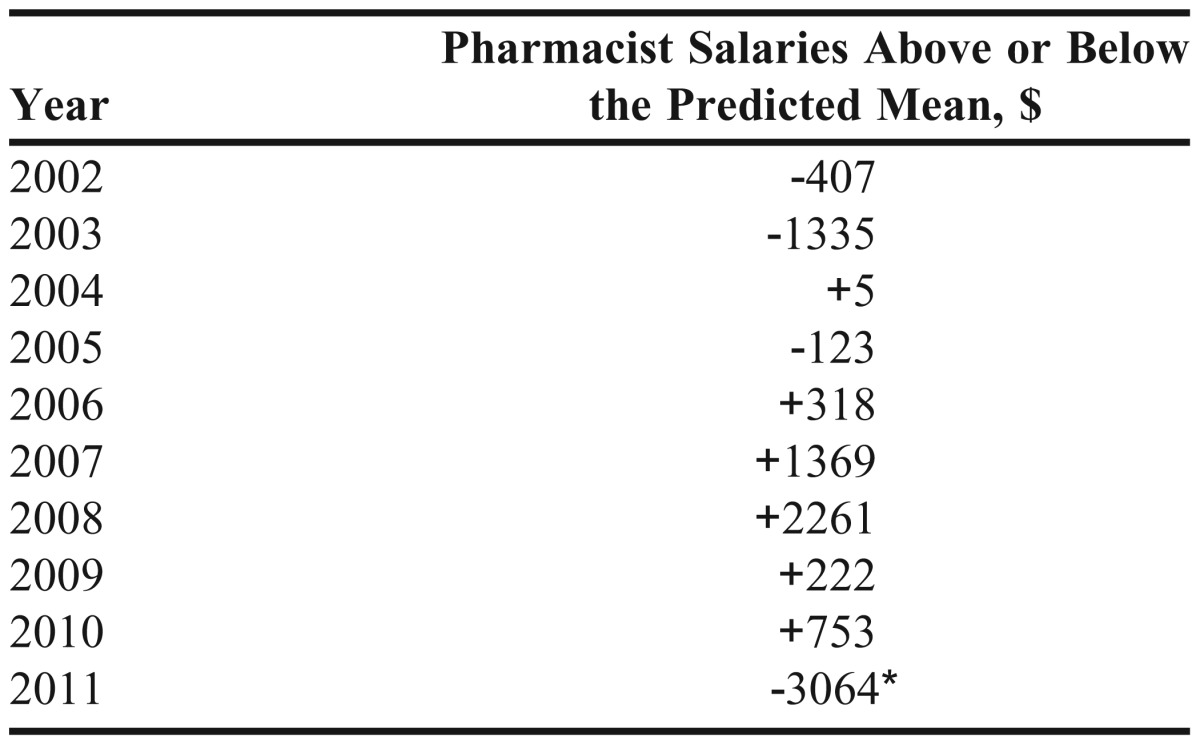
The increase in salary and number of jobs is not unique to the profession of pharmacy. The average salary of a health care professional in the United States over the last 10 years is shown in Figure 5 and the total number of health care professional jobs during that time is shown in Figure 6. Similar to the field of pharmacy, which had an approximate 49% increase in mean salary, all other health care professions examined in this study also had an increase in mean salary over the last 10 years (Figure 5). For comparison, internists have experienced an approximate 31% increase in salary ($158,000-$189,000 dollars). Similar to pharmacy, there has been significant growth in physical therapy jobs from 130,000 to 185,000 jobs over the last 10 years. Remaining health care professions saw little growth in total job numbers, staying within 10% of their starting number (Figure 6).
Figure 5.
Average salary of a health care professional in the United States over the last 10 years.
Figure 6.
Total number of health care professional jobs in the United States over the last 10 years.
Concurrent to the increases in tuition and salaries, student indebtedness also has increased over the last 5 years (Figure 7). While graduating pharmacy students had the second lowest student debt amount of $123,063, the amount of money that pharmacy students have borrowed to go to school has risen the fastest in the last 5 years (23%) compared to medical (4.7%) and dental students (8.5%). For illustrative purposes, total cost of loan scenarios were calculated for various interest rates and repayment schedules. Depending upon the scenario, total loan repayment amount for the average student loan debt could be as much as $361,847 (Table 2). As a measure for potential return on investment for pharmacy, dental, and medical education, we calculated the ratio between the average salary for a year and the respective average indebtedness of the student (SII ratio, described in methods). Table 3 shows that from 2008-2010, the first year in which the salary of a pharmacy graduate was greater than their total student-related indebtedness (reflected by numbers >1.0). However, in 2011 average indebtedness for pharmacy students ($114,422) was greater than the average first-year salary ($112,160) resulting in an SII of less than 1.0. Of note, the SII for medical students for the last 5 years was greater than 1.0 and for dental students was lower than 1.0 (Table 3).
Figure 7.
Trends in average graduating student indebtedness from 2008 to 2012, for three major health professions.
Table 2.
Total Cost of Student Loan Scenarios

Table 3.
The Salary to Indebtedness Index

DISCUSSION
Pharmacy college and school tuition and pharmacy student indebtedness increased considerably over the last decade. Salaries and number of jobs have increased for all the health professions, but there are some interesting aspects of the data pertaining to pharmacy alone. Although tuition has increased in a linear fashion, salaries and available positions have not increased at the same rate. The rates of tuition increase for public institutions suggest that these types of institutions are shifting more of the cost burden to students. Student indebtedness may be the most troublesome finding of this study. In 2011 the SII for pharmacy dropped below the 1.0 mark for the first time, indicating a potential decrease in the return on investment of a pharmacy education. Compared with medicine and dentistry, pharmacy’s SII has decreased the most. Whether this decrease is the beginning of a trend is unknown, as is the question of whether promising students will begin to reconsider pharmacy as a profession and choose another field such as medicine. Perhaps most disturbing, pharmacy students’ total debt increased 23% in the last 5 years, compared to only 4.7% and 8.5% for medical and dental students, respectively. Based on the average pharmacy student debt at graduation and depending on the terms, the total payout including interest for loan repayment could be in excess of $360,000. While most students’ total payback cost will be less than this, the dollar amount is still concerning. Reasons for the dramatic increase in pharmacy student debt load as compared to that experienced by other health professions students are not entirely clear. However, the authors speculate that rising tuition and subsequent student indebtedness is multi-faceted, arising from decisions within the academy, the accrediting bodies, governmental agencies, and faculty and student culture. Multiple questions arise from consideration of these issues. Have extensive accreditation requirements increased the direct and indirect cost of pharmacy education, particularly as applied to the experiential component? Has the academy engaged in an “arms race” in which pharmacy colleges and schools compete among themselves to provide the best marketing approach, state of the art facilities, and cutting edge technologies, effectively increasing the cost of education? Have government regulations played a role in increased indebtedness because of loan eligibility, interest rates, repayment rates, and deferment criteria? How much has decreased state funding to public institutions deflected education costs to students and their families? Have faculty members designed curricula that limit the amount of free time students have to obtain employment, even during winter and summer breaks? Finally, have students themselves opted for better lifestyles during pharmacy school at the expense of increased debt upon graduation? All of these questions deserve further study as to their potential effects on tuition and debt increases.
Although this paper provides a somewhat detailed analysis of the landscape of tuition, student debt, and salaries, it is not without limitations. First, tuition data obtained is in aggregate form and does not differentiate among programs of different lengths. Similarly, available pharmacist salary data is in aggregate form and does not account for differences in region, years of experience, type of practice setting, etc. When calculating some of the formulas, averages were used, which did not take into consideration the wide differences among individuals.
CONCLUSION
The increasing cost of pharmacy education in the United States is a growing concern and action is required to ensure that the best and brightest students are not deterred from pharmacy education by concerns of insurmountable debt after graduation. Rising tuition and increased student indebtedness is most likely a multifaceted issue that has origins within the academy, the accreditation process, federal and state governments, universities, and finally, student and faculty culture. This issue requires further exploration to assess causes and solutions to prevent the problem from growing.
ACKNOWLEDGEMENTS
The authors sincerely thank American Association of Colleges of Pharmacy (AACP) for the mentorship provided through the Academic Leadership Fellows Program (ALFP). The authors specifically thank the AACP staff involved in the ALFP for their constant support and guidance.
REFERENCES
- 1.Carey K. Here’s a diploma, with ball and chain attached. June 18, 2012. Chron Higher Educ. http://chronicle.com/article/Heres-a-Diploma-With-Ball/132309/. Accessed May 5, 2013.
- 2.Barrow L, Rouse CE. Does college still pay? Econ Voice. 2005;2(4):Article 3. [Google Scholar]
- 3.American Association of Colleges of Pharmacy. First year tuition and fees for PharmD degree program 2012-13. http://www.aacp.org/resources/student/pharmacyforyou/admissions/documents/table%2011.pdf. Accessed January 2, 2014.
- 4.American Association of Colleges of Pharmacy. Pharmacy graduating student survey summary report 2012. http://www.aacp.org/resources/research/institutionalresearch/Documents/2012_GSS_final%20summary%20report_all%20schools_105_with%20charts.pdf. Accessed May 5, 2013.
- 5.Sahota RK. Dental school debt: swimming to the surface or drowning. J California Dent Assoc. 2012;40(2):101–104. [PubMed] [Google Scholar]
- 6.Kerr JR, Brown JJ. Costs of a medical education: comparison with graduate education in law and business. J Am Coll Radiol. 2006;3(2):122–130. doi: 10.1016/j.jacr.2005.09.010. [DOI] [PubMed] [Google Scholar]
- 7.Youngclaus JA, Koehler PA, Kotlikoff LJ, Wiecha JM. Can medical students afford to choose primary care? An economic analysis of physician education debt repayment. Acad Med. 2013;88(1):16–25. doi: 10.1097/ACM.0b013e318277a7df. [DOI] [PubMed] [Google Scholar]
- 8.Asch DA, Nicholson S, Vujici M. Are we in a medical education bubble market? N Engl J Med. http://www.nejm.org/doi/pdf/10.1056/NEJMp1310778. Accessed January 2, 2014.
- 9.Association of American Medical Colleges. Trends in cost and debt at U.S. medical schools using a new measure of medical school cost of attendance. Analysis in Brief. aamc.org/download/296002/data/aibvol12_no2.pdf. Accessed May 5, 2013.
- 10.Association of American Medical Colleges. AAMC tuition and student fees report https://services.aamc.org/tsfreports/. Accessed May 5, 2013.
- 11.American Dental Education Association. Survey of dental school seniors, 2011 graduating class. http://www.adea.org/publications/tde/documents/seeallpredoctoralstudentdebttuitiongraphs.pdf. Accessed May 5, 2013.
- 12.American Dental Association Survey Center. 2010-11 Survey of Dental Education: Tuition, Admission, and Attrition (Group II, Question 15a). http://www.ada.org/sections/professionalResources/pdfs/survey_ed_vol2.pdf. Accessed May 5, 2013.
- 13.United States Department of Labor Bureau of Labor Statistics. Occupational Outlook Handbook. http://www.bls.gov/ooh/. Accessed May 5, 2013.
- 14.Brown DL. A looming joblessness crisis for new pharmacy graduates and the implications it holds for the Academy. Am J Pharm Educ. 2013;77(5):Article 90. doi: 10.5688/ajpe77590. [DOI] [PMC free article] [PubMed] [Google Scholar]
- 15.Knapp K, Schommer JC. Finding a path through times of change. Am J Pharm Educ. 2013;77(5):Article 91. doi: 10.5688/ajpe77591. [DOI] [PMC free article] [PubMed] [Google Scholar]
- 16.American Association of Colleges of Pharmacy. Tuition trend data. http://www.aacp.org/resources/research/institutionalresearch/Documents/TrendData/Tutition/Tuition1112.htm. Accessed May 5, 2013.
- 17.National Center for Education Statistics. Digest of education statistics. Table 352: Average graduate and first-professional tuition and required fees in degree-granting institutions, by first-professional field of study and control of institution: 1989-90 through 2010-11. http://nces.ed.gov/programs/digest/d11/tables/dt11_352.asp. Accessed May 5, 2013.
- 18.American Association of Colleges of Pharmacy. Graduating student survey information and summary reports. http://www.aacp.org/resources/research/institutionalresearch/Pages/GraduatingStudentSurvey.aspx. Accessed May 5, 2013.
- 19.Federal Student Aid. Repayment Estimator. http://studentaid.ed.gov/repay-loans/understand/plans/standard/comparison-calculator. Accessed January 2, 2014.



